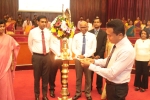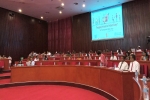The evolution of a National Quality Assurance Program in Sri Lankan Health Services dates back to 1989. With the publishing of the handbook on the National Quality Assurance Program in 1995 by the Ministry of Health, some institutions embraced the concept to introduce quality improvement program in their own institutions. The Quality Assurance Program was re-launched in 2000 with the concept 'Quality Healthcare through Productivity'.
The Castle Street Hospital for Women (Teaching) was identified as the focal point for the National Quality Assurance Program and then Castle Street Hospital was identified as the focal point for the National Quality Assurance Program of the Ministry of Health. Since then measures have been taken to expand this program to other hospitals island wide. As a result, hospitals such as Ampara DGH, Peradeniya TH and Kurunegala PGH have initiated their quality improvement program. It was believed that quality improvement program can be implemented only in the line ministry institutions because of the limited availability of resources in other hospitals. The Quality improvement program at Mahiyangana BH in 2004 - 2005 paved the pathway for hospitals which are governed by Provincial Councils and other smaller hospitals to improve quality in their hospitals. With this experience, a pilot study was carried out in five hospitals of different administrative levels in North Western Province. This gave an insight on the carrying out of the quality improvement program for the Ministry of Health. In 2007-2009, with this experience, the program was expanded to eight hospitals in the Southern and Uva Provinces. With these pilot studies it was identified that these ablishment of a District Quality Assurance Unit and Quality Management Unit are important to facilitate and monitor the quality improvement program. It was also recommended that an apex body be established to facilitate the quality improvement program through out the country. There fore, under the World Bank–HSDP funds,a building was constructed for the National Quality Assurance Program.
A consultative committee was appointed to decide on the scope and functions of the Directorate of Health care Quality and Safety. It was commissioned in August 2012.The Director at e functions under the principle of' A Centrally Driven, Locally Lead, Clinically Oriented, Patient Centered, Continuous Quality Improvement Program. The Directorate have carried out much good work related to the quality improvement program of the Ministry of Health in a planned manner since it was commissioned in August 2012. These included commencement of Monitoring and Evaluation mechanisms and Performance Review meetings for Line Ministry (42) Quarterly; and Provincial institutions- Base Hospitals Type B and above (101) biannually. The Directorate also created a platform for sharing experiences in 2013.
In 2013, twenty General Indicators and Performance Indicators (Checklist) and Surgical Safety Checklist (Circular and Guidelines) were introduced and in 2015, besides the development of the National Policy on Healthcare Quality and Safety, the Master Trainers Manual on Quality and Safety were also published in all three languages. Annual trainings were initiated for Training of Trainers workshops on 5S, CQI and TQM and there were also Training Workshops on Patient Safety for middle and top-level managers of hospitals. In 2016 Adverse Event Reporting Mechanism was established and Readmission Forms and Guidelines were introduced. Training on Clinical Audits was introduced in 2017. A Film on 'Responsiveness in Healthcare’ (Tele Documentary) was produced and there was a Revision of Performance Review format. There was also introduction of Clinical Indicators for four major specialties. In 2018, there was conduct of Surveyor Induction workshop and Gap Analysis in six hospitals in collaboration with ACHS.
In August 2019, in line with the functions of the Directorate of Healthcare Quality & Safety (DHQS) to coordinate and systematically implement the national policy, it requested the WHO to support the development of a Strategic Plan for Patient Safety and Quality of Care for 2020-2024 Stakeholder working groups was identified and initiated for the Key Results Areas of the national policy. The revised national policy was co-developed with stakeholder consensus. The importance of local leadership ownership, data management and peer benchmarking were emphasized. The successful implementation of the policy will bring Sri Lanka’s patient safety and healthcare quality to the next level, achieving mature status for the patient safety and quality processes, consistent with the new WHO Global Patient Safety standards and supporting the 2019 World Health Assembly resolution on Global Action on Patient Safety.








